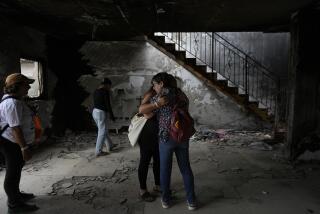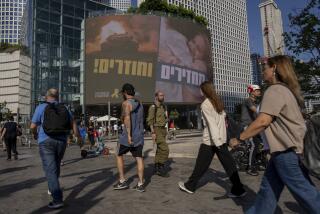Fear, Defiance and Curiosity Amid Chaos
BAGHDAD — Friday night in Baghdad brought thunder, fire and smoke -- and the image of the pyramid-shaped headquarters of the Iraqi intelligence service glowing from the inside like a saw-toothed jack o’ lantern as it burned from repeated hits from U.S. cruise missiles and B-52 bombers.
Orange, red and yellow tracer rounds filled the sky, marking the aim of anti-aircraft fire, and the ground shook and buildings trembled as though the city was in the throes of a series of violent earthquakes.
After a sunny, peaceful day, when many Baghdad residents put aside their fears and ventured outside, the air raid sirens sounded their doleful wail at 8:05 p.m. Five minutes later, a giant tap dance of explosions began.
Tomahawk cruise missiles sent flying from the Persian Gulf rained down in quick succession on the Old Palace compound that sits just opposite the commercial heart of the city, stretching out for 1.7 miles on the bank of the Tigris River.
Like a choreographed fireworks display, one building after another exploded in bright yellow flames, quickly smothered in clouds of dust and debris.
The initial blasts went on for 10 minutes, succeeded by a series of more leisurely hammer blows. Then, at around 9:30 p.m., the B-52s arrived. The attack flowed, punctuated by a constant wail of civil defense sirens, the occasional screeching of low-flying U.S. fighter jets and the rat-tat-tat of anti-aircraft artillery firing futilely from all directions to intercept the attackers.
Across the river, windows shattered and car alarms squealed from the shock waves of the explosions, which rushed by like sharp gusts of wind. At one point, looking down from the balcony of the Palestine Hotel, the only creature moving was a stray tawny dog -- loping in terror in the middle of Abu Niwas Street which parallels the embankment.
Inside the hotel, some raced for shelters or crouched in corridors trembling. Others could not resist the spectacle and cautiously approached their windows and balconies. Some Iraqis, drawn by curiosity rather than good sense, stepped out onto the sidewalks, braving the shower of anti-aircraft fragments careening across the skies.
The raids continued until about 10:30 p.m. Sporadic distant explosions were heard like the rumble of distant thunder until the first call to prayer before dawn Saturday.
During the night, fires could be seen burning on the southern, eastern and western flanks of the city, although it was impossible to discern the exact targets, and thick stacks of white and black smoke and dust drifted overhead. It appeared that the al-Rashid military base south of Baghdad -- which was struck during the first day of raids Thursday -- may have been hit again.
The battered intelligence headquarters has served as the home of the much-feared Special Security, the organization that pervades life in Iraq with its legions of listeners and informants. It burned for hours from within, but its sloped concrete sides, resembling the architecture of the Aztecs, remained intact.
The attack was by far the fiercest on the Iraqi capital since the 1991 Persian Gulf War. But the first impression was that the munitions were highly accurate. There was no immediate reports of any bombs striking civilian areas and television, telephones and electric power all continued to function.
As mayhem and destruction reigned on the west bank of the Tigris, a view of the rest of the city on the east bank was eerily normal, except for racing ambulances.
Plain-clothed security agents seemed extremely nervous about allowing the images of the burning presidential and military buildings to reach the outside world. They shooed news photographers off balconies in the hotel and brusquely took away film and cameras.
During the height of the bombing, Defense Minister Sultan Hishami appeared on Iraqi state television and announced that U.S. paratroopers had landed at two locations in western Iraq -- Arotba and Achetri -- near the border with Jordan. He said local residents were resisting the American invaders.
Throughout the day, officials continued to predict victory and preach defiance. That attitude was clear in the appearance of Interior Minister Mahmoud Diab Ahmad at a news conference. Robust and tall with graying hair, he held a shiny chrome-plated Kalashnikov rifle in one hand and wore an olive khaki ammo vest carrying four full clips and a fearsome looking knife. On his hip he had a holstered pistol.
“You may ask why I am dressed like this and why I have a gun. I took an oath to God that I will put my gun down only one the day of our victory. And my 12-year old son has a machine gun too,” he told assembled reporters.
Hunting for successes, Iraqi state radio announced that Hussein had decreed an award of 100 million Iraqi dinars (about $33,000) to anyone who shoots down a U.S. or British airplane, and 50,000 dinars (about $16,000) to anyone who shoots down a helicopter or captures an enemy soldier.
Officials also wanted to highlight civilian casualties. During the first bombing attack Thursday, the Iraqi government said, one woman was killed and 14 others hurt. Among the military, there were four killed and six wounded, officials said, with 72 bombs and missiles landing.
At the al-Kindi Hospital in east Baghdad, one of two main trauma centers, Dr. Dhiak Jaddu said 12 people had been admitted as of Friday morning. He told visiting journalists they should not count just the number of people hit by shrapnel or anti-aircraft fire, but also those suffering stress and hypertension or heart attacks because of the sheer terror of bombing.
Among the wounded was Ahmed Sabbar Kadim, an 18-year-old high school student from Zafarania, near the Rashid Base. On Friday, a nurse gave him a pain-killing injection as he grimaced. Speaking in a low monotone, he described being knocked unconscious by the force of a bomb blast when returning home from a neighbor’s house.
He remembered seeing only a bright flash, he said.
Nevertheless, the relatively few civilian casualties and the focus on government and military targets seemed part of a calculated U.S. strategy to attack the government while causing the least disruption possible to ordinary Iraqis.
“The surgical strikes are intended to demonstrate to the population that that the U.S. military machine seeks to avoid civilian casualties and makes a distinction between Saddam from his people,” said a European diplomat who has remained in Baghdad.
In contrast, Iraqi Information Minister Mohammed Saeed Sahhaf lashed out at the “barbaric bombing of civilian targets in Baghdad.”
Showing gory photographs of wounded civilians, he said, “These are the people targeted by the criminal George Bush and his gang and the mercenaries in Kuwait and the Gulf.”
Referring to the U.S. attack Thursday on the personal residences of Hussein, his wife, and family, Sahhaf called the United States a “superpower of villains. They are the superpower of Al Capone.”
Both Sahhaf and Diab ridiculed reports that the U.S. and British forces were making rapid incursions into Iraq, saying they may have entered only “a few kilometers.” They denied that the port city of Umm Qasr hand fallen, and said that televised images of Iraqi soldiers surrendering with white flags was fakery concocted by the United States.
Iraqi morale will not be affected by the ebb and flow of air strikes and other “tricks” of the United States, said Sahhaf. “Our morale is based on a deep belief that we are the just side and not those villains.”
“You will see in the next few days that our victory is certain, certain, certain,” said Diab, the interior minister.
Some ordinary Iraqis saw it differently. “People are scared,” said one man, who asked not to be identified. “There is a big difference between American power and Iraqi power.”
More to Read
Sign up for Essential California
The most important California stories and recommendations in your inbox every morning.
You may occasionally receive promotional content from the Los Angeles Times.










